Dylan Thomas
| Dylan Thomas | |
|---|---|
| Born | 27 October 1914[1] Swansea, South Wales, UK[1] |
| Died | 9 November 1953 (aged 39)[1] New York, USA[1] |
| Occupation | Poet and writer |
| Literary movement | Modernism Romanticism |
| Spouse(s) | Caitlin Macnamara (1937–1953) |
| Children | Llewellyn Edouard Thomas (1939–2000) Aeronwy Bryn Thomas (1943–2009) Colm Garan Hart Thomas (b. 1949) |
|
Influences
|
|
|
Influenced
|
|
Dylan Marlais Thomas (27 October 1914 – 9 November 1953) was a Welsh poet and writer[1][2] who wrote exclusively in English. In addition to poetry, he wrote short stories and scripts for film and radio, which he often performed himself. His public readings, particularly in America, won him great acclaim; his sonorous voice with a subtle Welsh lilt became almost as famous as his works. His best-known works include the "play for voices" Under Milk Wood and the celebrated villanelle for his dying father, "Do not go gentle into that good night". Appreciative critics have also noted the superb craftsmanship and compression of poems such as "In my Craft or Sullen Art"[3] and the rhapsodic lyricism of "Fern Hill'".
Contents |
Early life
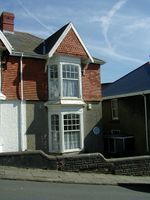
Dylan Thomas was born at 5 Cwmdonkin Drive [4] in the Uplands area of Swansea, South Wales, on 27 October 1914 just a few months after the Thomas family had bought the house. Uplands was, and still is, one of the more affluent areas of the city, away from the more industrial areas. His father, David John ('DJ') Thomas, was an English master who taught English literature at the local grammar school. His mother, Florence Hannah Thomas (née Williams), was a seamstress born in Swansea. Nancy, Thomas's sister, was nine years older than he. Their father brought up both children to speak English only, even though both parents also knew Welsh and DJ was known to give Welsh lessons at home.
Dylan is pronounced ˈdəlan in Welsh, and in the early part of his career some announcers introduced him using this pronunciation. However, Thomas himself favoured the anglicised pronunciation English pronunciation: /ˈdɪlən/ his mother was afraid that the Welsh pronunciation would be heard as "Dull One" . His middle name, Marlais, was given to him in honour of his great-uncle, Unitarian minister William Thomas, whose bardic name was Gwilym Marles.
His childhood was spent largely in Swansea, with regular summer trips to visit his maternal aunts' Carmarthenshire farms.[5] These rural sojourns and the contrast with the town life of Swansea provided inspiration for much of his work, notably many short stories, radio essays, and the poem Fern Hill. Thomas was known to be a sickly child who shied away from school and preferred reading on his own and was considered too frail to fight in World War II, instead serving the war effort by writing scripts for the government. He suffered from bronchitis and asthma. Thomas's formal education began at Mrs. Hole's Dame school, a private school which was situated a few streets away on Mirador Crescent. He described his experience there in Quite Early One Morning [6]
Never was there such a dame school as ours, so firm and kind and smelling of galoshes, with the sweet and fumbled music of the piano lessons drifting down from upstairs to the lonely schoolroom, where only the sometimes tearful wicked sat over undone sums, or to repent a little crime — the pulling of a girl's hair during geography, the sly shin kick under the table during English literature."
In October 1925, Thomas attended the single-sex Swansea Grammar School, in the Mount Pleasant district of the city. Thomas's first poem was published in the school's magazine. He later became its editor. He left school at 16 to become a reporter for the local newspaper, the South Wales Daily Post only to leave the job under pressure 18 months later in 1932. He then joined an amateur dramatic group in Mumbles, but still continued to work as a freelance journalist for a few more years.
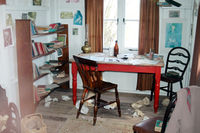
Thomas spent his time visiting the cinema in the Uplands, walking along Swansea Bay, visiting a theatre where he used to perform at, and frequenting Swansea's pubs. He especially patronised those in the Mumbles area such the Antelope Hotel and the Mermaid Hotel. A short walk from the local newspaper where he worked was the Kardomah Café in Castle Street, central Swansea. At the cafe he met with various artist contemporaries, such as his good friend and poet Vernon Watkins. These writers, musicians, and artists became known as 'The Kardomah Gang'. In 1932, Thomas embarked on what would be one of his various visits to London.
In February 1941, Swansea was bombed by the German Luftwaffe in a "three nights' blitz". Castle Street was just one of the many streets in Swansea that suffered badly; the rows of shops, including the 'Kardomah Café', were destroyed. Thomas later wrote about this in his radio play Return Journey Home, in which he describes the café as being "razed to the snow". Return Journey Home was first broadcast on 15 June 1947, having been written soon after the bombing raids. Thomas walked through the bombed-out shell of the town centre with his friend Bert Trick. Upset at the sight, he concluded, "Our Swansea is dead".[7] The Kardomah Café later reopened on Portland street, not far from the original location.
Career
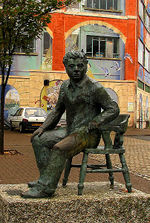
Thomas wrote half of his poems and many short stories while living at 5 Cwmdonkin Drive.[8] "And death shall have no dominion", one of his best known works, was written at this address, and published here too. His highly acclaimed first poetry volume, 18 Poems, was published on 18 December 1934, the same year he moved to London. The publication of 18 Poems won him many new admirers from the world of poetry, including Edith Sitwell; although it was also the time that his reputation for heavy drinking developed. The house itself has recently been restored to its original condition.[9]
At the outset of the Second World War Thomas was designated C3, which meant that although he could, in theory, be called up for service he would be in one of the last groups to be so. He was saddened to see his friends enter active service leaving him behind and drank whilst struggling to support his family. He wrote to the director of the films division of the Ministry of Information asking for employment but after a rebuff eventually ended up working for Strand Films. Strand produced films for the Ministry of Information and Thomas scripted at least five in 1942 with titles such as This Is Colour (about dye), New Towns For Old, These Are The Men and Our Country (a sentimental tour of Britain).[10]
The publication of Deaths and Entrances in 1946 was a major turning point[11][12][13] in his career. Thomas was well known for being a versatile and dynamic speaker, best known for his poetry readings.[14] His powerful voice would captivate American audiences during his speaking tours of the early 1950s. He made over 200 broadcasts for the BBC. Often considered his greatest single work is Under Milk Wood, a radio play featuring the characters of Llareggub, a fictional Welsh fishing village (humorously named; note that 'Llareggub' is 'Bugger All' backwards, implying that there is absolutely nothing to do there). The BBC credited their producer Stella Hillier with ensuring the play actually materialised. Assigned "some of the more wayward characters who were then writing for the BBC", she dragged the notoriously unreliable Thomas out of the pub and back to her office to finish the work.[15] The play took several years to write. The first half was mostly written in South Leigh, Oxford, in 1948, whilst the second half was mostly written in America in May 1953. Fewer than 300 lines were written in Laugharne, according to one account, which also explains the influence of New Quay on the play.[16]
Thomas performed Under Milk Wood solo for the first time on 3 May at Harvard during his early 1953 US tour, and then with a cast at the Poetry Centre in New York on 14 May. He worked on the play in England, and returned to the States in October, but died in New York on 5 November, before the BBC could record the play.[17] Richard Burton starred in the first broadcast in 1954; he was joined by Elizabeth Taylor in a subsequent film.
Marriage and children
In the spring of 1936, Dylan Thomas met the dancer Caitlin MacNamara. They met in the Wheatsheaf pub, in the Fitzrovia area of London's West End. They were introduced by Augustus John, who was MacNamara's lover at the time (there were rumours that she continued her relationship with John after she married Thomas). A drunken Thomas proposed to MacNamara on the spot, and the two began a courtship.[18]
On 11 July 1937, Thomas married MacNamara in a registry office in Penzance, Cornwall. In 1938, the couple rented a cottage in the village of Laugharne, Carmarthenshire, West Wales. Their first child, Llewelyn Edouard, was born on 30 January 1939 (d. 2000). Their daughter, Aeronwy Thomas-Ellis, was born on 3 March 1943 (d. 2009). A second son, Colm Garan Hart, was born on 24 July 1949.
Death
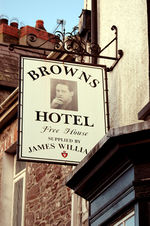
Thomas arrived in New York on 20 October 1953, to take part in a performance of Under Milk Wood at the city's prestigious Poetry Centre. He was already ill and had a history of blackouts and heart problems, using an inhaler in New York to help his breathing. Thomas had liked to boast off his addiction to drinking, saying "An alcoholic is someone you don't like, who drinks as much as you do." [19] He "liked the taste of whisky" and had a powerful reputation for his drinking, which became a part of Dylan Thomas mythology. The amount he is supposed to have drunk in his lifetime and in New York before his death, may well have been exaggerated.
On October 28, he took part in Poetry And The Film, a recorded symposium at Cinema 16, which included panellists Amos Vogel, Maya Deren, Parker Tyler, and Willard Maas. The director of the Poetry Centre, John Brinnin, was also Thomas's tour agent. Brinnin didn't travel to New York, remaining at home in Boston and handed responsibility to his assistant, Liz Reitell.[20] Reitell met Thomas at Idlewild Airport (now JFK airport) and he told her that he had had a terrible week, had missed her terribly and wanted to go to bed with her. Despite Reitell's previous misgivings about their relationship they spent the rest of the day and night together at the Chelsea. The next day she invited him to her apartment but he declined, saying that he was not feeling well and retired to his bed for the rest of the afternoon. After spending the night with him at the hotel Reitell went back to her own apartment for a change of clothes. At breakfast Herb Hannum noticed how sick Thomas looked and suggested a visit to a Dr. Feltenstein before the performance of Under Milk Wood that evening. The doctor went to work with his needle, and Thomas made it through the two performances of Under Milk Wood, but collapsed straight afterwards. Reitell would later describe Feltenstein as a wild doctor who believed injections could cure anything.
On the evening of 27 October 1953, Thomas's 39th birthday, the poet attended a party in his honour but felt so unwell that he returned to his hotel. A turning point came on 2 November. Air pollution in New York had risen significantly and exacerbated chest illnesses, such as Thomas had. By the end of the month, over two hundred New Yorkers had died from the smog.[20] On 3 November, Thomas returned to the Chelsea Hotel, after drinking at the White Horse Tavern, a favourite pub he'd found through Scottish poet Ruthven Todd. Thomas declared, "I've had eighteen straight whiskies. I think that is a record!" [21] The barman and the owner of the pub who served Thomas at the time, later told Todd that Thomas couldn't have imbibed more than half that amount. Thomas had an appointment to visit a clam house in New Jersey on 4 November. When phoned at the Chelsea that morning, he said that he was feeling awful and asked to take a rain-check. Later, he did go drinking with Reitell at the White Horse Tavern and, feeling sick again, returned to the hotel. Dr. Feltenstein came to see him three times that day, on the third call prescribing morphine, which seriously affected Thomas's breathing. At midnight on 5 November, his breathing became more difficult and his face turned blue. Reitell unsuccessfully tried to get hold of Feltenstein. By 01:58 Thomas had been admitted to the emergency ward at nearby St Vincent's hospital, by which time he was comatose. The duty doctors found bronchitis in all parts of his bronchial tree, both left and right sides. An X-ray showed pneumonia, and a raised white cell count confirmed the presence of an infection. The pneumonia worsened and Thomas died on 9 November.
The first rumours to circulate were of a brain haemorrhage, followed by reports that he had been mugged and soon stories began to fly that he had drunk himself to death. Later, there were speculations about drugs and diabetes. At the post-mortem, the pathologist found that the immediate cause of death was swelling of the brain, caused by the pneumonia reducing the supply of oxygen. Despite his heavy drinking his liver showed little sign of cirrhosis. His biographer Lycett, ascribed the demise of Dylan's health to an alcoholic co-dependent relationship with his wife Caitlin, who deeply resented his affairs.[22] In Fatal Neglect: Who Killed Dylan Thomas?, David N Thomas refutes the idea that alcoholism contributed to the poet's death. The book suggests Dylan Thomas was the victim of Dr. Feltenstein who administered morphine for delirium tremens, when Thomas in fact had pneumonia. He also suggests that Feltenstein covered his tracks by pressuring other doctors to agree that it was an alcohol-related death. He points to John Brinnin's culpability, as Thomas's agent, and suggests Brinnin neglected his duty of care.[23] Caitlin Thomas's two searing autobiographies -Double Drink Story: My life with Dylan and Caitlin Thomas - Leftover Life to Kill - both describe the highly destructive effect of alcoholism to the poet and to their relationship. "Ours was not only a love story, it was also a drink story", she writes. "The bar was our altar".[24]
Following his death, his body was brought back to Wales for his burial in the village churchyard at Laugharne on 25 November. One of the last people to stay at his graveside after the funeral was his mother, Florence. Thomas's obituary was written by his long-time friend and Welsh poet Vernon Watkins. His wife, Caitlin, died in 1994 and was buried alongside him.
Style
Thomas's verbal style played against strict verse forms, such as the villanelle Do not go gentle into that good night. His images were carefully ordered in a patterned sequence, and his major theme was the unity of all life, the continuing process of life and death and new life that linked the generations. Thomas saw biology as a magical transformation producing unity out of diversity, and in his poetry he sought a poetic ritual to celebrate this unity. He saw men and women locked in cycles of growth, love, procreation, new growth, death, and new life again. Therefore, each image engenders its opposite. Thomas derived his closely woven, sometimes self-contradictory images from the Bible, Welsh folklore and preaching, and Freud.[25]
In reply to a letter in which the writer expressed their love for his poetry but was concerned that they may have misunderstood what the poet meant, Thomas replied that a poem was like a city having many entrances.[26]
Poetry
Thomas's poetry is famous for its musicality, most notable in poems such as Fern Hill, In the White Giant's Thigh, In Country Sleep and Ballad of the Long-legged Bait. Do not go gentle into that good night, possibly his most popular poem, is unrepresentative of his usual poetic style. Following are a few examples.
From In my Craft or Sullen Art:[27]
Not for the proud man apart
From the raging moon I write
On these spindrift pages
Nor for the towering dead
With their nightingales and psalms
But for the lovers, their arms
Round the griefs of the ages,
Who pay no praise or wages
Nor heed my craft or art.
From In the White Giant's Thigh [28]
Who once were a bloom of wayside brides in the hawed house
and heard the lewd, wooed field flow to the coming frost,
the scurrying, furred small friars squeal in the dowse
of day, in the thistle aisles, till the white owl crossed. . .
Thomas's poem And death shall have no dominion is noted for its metaphysical sentiment and assertion of the eternal continuity of life in nature.
And death shall have no dominion.
Dead men naked they shall be one
With the man in the wind and the west moon;
When their bones are picked clean and the clean bones gone,
They shall have stars at elbow and foot;
Though they go mad they shall be sane,
Though they sink through the sea they shall rise again
Though lovers be lost love shall not;
And death shall have no dominion.
Thomas once confided that the poems which had most influenced him were Mother Goose rhymes which his parents taught him when he was a child. He did not understand all of their contents, but he loved their sounds, and the acoustic qualities of the English language became his focus in his work later. He claimed that the meanings of a poem were of "very secondary nature" to him.
Thomas memorials
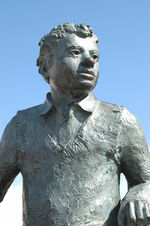
A statue of Thomas is in the city's maritime quarter. The Dylan Thomas (Little) Theatre and the Dylan Thomas Centre, formerly the town's Guildhall, are also found in Swansea. The latter is now a literature centre, where exhibitions and lectures are held, and is the setting for an annual 'Dylan Thomas Festival'. Another monument to Thomas stands in Cwmdonkin Park, one of his favourite childhood haunts, close to his birthplace at 5 Cwmdonkin Drive. The memorial is a small rock in a closed-off garden, set within the park. The rock is inscribed with the closing lines from Fern Hill
- Oh as I was young and easy in the mercy of his means
- Time held me green and dying
- Though I sang in my chains like the sea.
Thomas's home in Laugharne, the Boat House, has been made a memorial. Several of the pubs in Swansea also have associations with the poet. One of Swansea's oldest pubs, the No Sign Bar, was a regular haunt of Thomas's. It is mentioned in his story, The Followers but has subsequently been renamed the 'Wine Vaults'. And since, has been re-named The No-Sign Wine Bar. A class 153 diesel multiple unit was named Dylan Thomas 1914–1953. In 2004 a new literary prize, the Dylan Thomas Prize,[29] was created in honour of the poet. It is awarded to the best published writer in English under the age of 30. Following this, in 2005, the Dylan Thomas Screenplay Award[30] was established. The prize is administered by the Dylan Thomas Centre, and is awarded at the annual Swansea Bay Film Festival. In 1982, a plaque was unveiled in honour of Dylan Thomas, in Poets' Corner, Westminster Abbey.
Bibliography
- Poetry collections
- 18 Poems (1934)[OOP]
- The Map of Love (1939) [OOP]
- Twenty-Five Poems (1936) [OOP]
- New Poems (1943) [OOP]
- Deaths and Entrances (1946) [OOP]
- Twenty-Six Poems (1950) [OOP]
- In Country Sleep (1952) [OOP]
- Collected Poems, 1934–1952 (1952)
- Collected Prose
- Collected Letters
- Collected Stories
- Portrait of the Artist as a Young Dog (1940 Dent)
- Quite Early One Morning (posthumous)
- Adventures In The Skin Trade And Other Stories (1955, posthumous)
- Selected Writings of Dylan Thomas (1946) [OOP]
- A Prospect of the Sea (1955) [OOP]
- A Child's Christmas in Wales (1955)
- Letters to Vernon Watkins (1957)
- Rebecca's Daughters (1965)
- After the Fair
- The Tree
- The Dress
- The Visitor
- The Vest
- Drama
- Under Milk Wood
- The Doctor and the Devils and Other Scripts (1953)
- Collected Miscellaneous
- The Beach of Falesa (1964) [OOP]
- Dylan Thomas — a Collection of Critical Essays: Charles B. Cox (ed.) (1966) [OOP]
- Selected Works (The Map of Love, Selected Poems and Under Milk Wood) Guild Publishing, London 1982
- The Collected Stories of Dylan Thomas (1984)
- The Poems of Dylan Thomas (1979)
- On the Air With Dylan Thomas: The Broadcasts
- Eight Stories (1993)
- Dylan Thomas: The Complete Screenplays (1995)
- Fern Hill: An Illustrated edition of the Dylan Thomas poem. [1998]
- Collected Poems 1934 – 1953 (London: Phoenix, 2003)
- Selected Poems (London: Phoenix, 2001)
Discography
- Dylan Thomas: Volume I — A Child's Christmas in Wales and Five Poems (Caedmon TC 1002–1952)
- Under Milk Wood (Caedmon TC 2005–1953)
- Dylan Thomas: Volume II — Selections from the Writings of Dylan Thomas (Caedmon TC 1018–1954)
- Dylan Thomas: Volume III — Selections from the Writings of Dylan Thomas (Caedmon TC 1043)
- Dylan Thomas: Volume IV — Selections from the Writings of Dylan Thomas (Caedmon TC 1061)
- Dylan Thomas: Quite early one morning and other memories (Caedmon TC 1132–1960)
- Dylan Thomas: Under Milk Wood and other plays (Naxos Audiobooks NA288712 – 2008) (originally BBC – 1954)
Filmography
- "The Edge of Love", 2008, directed by John Mybury, written by Sharman Macdonald
- Dylan Thomas: A War Films Anthology (DDHE/IWM D23702 – 2006 (DVD Region 0))
- Under Milk Wood, 1972, starring Richard Burton, Elizabeth Taylor, and Peter O'Toole
- A Child's Christmas in Wales, a 1987 film based on Dylan Thomas's work of the same name. Directed by Don McBrearty.
- Rebecca's Daughters starring Peter O'Toole and Joely Richardson
Other media representations
- 1964: Dylan, a Broadway play by Sidney Michaels starring Alec Guinness as Dylan.
- 1978: Dylan, movie about Dylan Thomas's final visit to America, concluding with his death in New York on 9 November 1953. Directed by Richard Lewis.
- 1990–91: Dylan Thomas: Return Journey, a one-man stage show featuring Bob Kingdom as Thomas and directed by Anthony Hopkins.[31]
- 2008: The Edge of Love, movie about WWII events starring Matthew Rhys as the poet.
- 2008: Marillion's 2008 Christmas CD (Pudding On The Ritz) contains a reading of A Child's Christmas In Wales put to music written by the band.[32]
References
- ↑ 1.0 1.1 1.2 1.3 1.4 "Dylan Thomas", Encyclopædia Britannica . Retrieved 11 January 2008.
- ↑ "Biography – Dylan Thomas", BBC Wales, 11 January 2008
- ↑ "''In my craft or sullen art'' retrieved October 29, 2008". Naic.edu. http://www.naic.edu/~gibson/poems/dthomas1.html. Retrieved 2009-10-17.
- ↑ 5 Cwmdonkin Drive
- ↑ Dylan Remembered 1914-34 vol 1 by D N Thomas, Seren 2003
- ↑ Quite Early One Morning. New Directions Publishing, 1968.
- ↑ Dylan Remembered 1935-53 vol 2 by D N Thomas, Seren 2004 p92
- ↑ Website of Thomas's home at 5 Cwmdonkin Drive
- ↑ George Tremlett, Dylan Thomas: In the Mercy of His Means (London: Constable, 1991), ISBN 0-09-472180-7
- ↑ Lycett, Andrew (2008-06-21). "The reluctant propagandist". The Guardian (London). http://arts.guardian.co.uk/theatre/drama/story/0,,2286844,00.html. Retrieved 2008-06-24.
- ↑ "It is difficult to convey in a few words the quality of Mr Thomas's poetry"—Vita Sackville-West, The Observer.
- ↑ "Dylan Thomas is not only the best living Welsh poet, but is a great poet."—John Betjeman, The Daily Herald.
- ↑ "This book alone, in my opinion, ranks him as a major poet"—W. J. Turner, The Spectator.
- ↑ Poem of the Week from 10/29/97
- ↑ Nick Serpell, Veterans pass on the baton, BBC Obituaries, 1 December 2008
- ↑ D N Thomas (2004) Dylan Remembered 1935-53, vol 2, Seren, p285-313; published papers collected at http://undermilkwood.webs.com
- ↑ Nicola Soames, CD notes from Dylan Thomas: Under Milk Wood, Naxos Audiobooks.
- ↑ Thorpe, Vanessa (2006-11-26). "Race to put the passion of Dylan's Caitlin on big screen | UK News | The Observer". London: Observer.guardian.co.uk. http://observer.guardian.co.uk/uk_news/story/0,,1957289,00.html. Retrieved 2009-10-17.
- ↑ "Dylan Thomas Quotes". Famouspoetsandpoems.com. 2007-05-17. http://famouspoetsandpoems.com/poets/dylan_thomas/quotes. Retrieved 2009-10-17.
- ↑ 20.0 20.1 Fatal Neglect: Who Killed Dylan Thomas? by D N Thomas, Seren 2008
- ↑ Dylan Thomas Walking Tour
- ↑ Lycett 2003
- ↑ Fatal Neglect: Who Killed Dylan Thomas?, by D N Thomas Seren 2008
- ↑ Thomas, Caitlin (1957) Caitlin Thomas - Leftover Life to Kill; Thomas, Caitlin (2008) Double Drink Story: My life with Dylan. Virago Press Ltd. Both are available via internet but currently out of print.
- ↑ M. H. Abrams and Stephen Greenblatt, eds., The Norton Anthology of English Literature (New York: W.W. Norton & Company, Inc.), 2705–2706.
- ↑ "Poetry is the cornerstone of civilisation", A. A Gill, 8 March 2008 Sunday Times
- ↑ In My Craft Or Sullen Art, by Dylan Thomas on 'Famous Poets and Poems' website
- ↑ In the White Giant's Thigh
- ↑ "Dylan Thomas Prize". Dylan Thomas Prize. http://www.thedylanthomasprize.com/. Retrieved 2009-10-17.
- ↑ "2010". Sbff09.com. http://www.sbff09.com. Retrieved 2009-10-17.
- ↑ Dylan Thomas: Return Journey Details on Theatres International website
- ↑ "MUSIC — Discography — Christmas 2008 | The Official Marillion Website". marillion.com. http://www.marillion.com/music/xmas/2008.htm. Retrieved 2009-10-17.
Further reading
- Brinnin, J M Dylan Thomas in America: an intimate journal, 1957
- Gilbar & Stewart Literary Santa Barbara 1998, pp. 248–252
- Lycett, Andrew. Dylan Thomas — A new life, 2003
- Thomas, Caitlin Leftover Life to Kill, 1957
- Thomas, David N. Fatal Neglect: Who Killed Dylan Thomas? David N. Thomas, Seren 2008
- Thomas, David N. Dylan Remembered – Volume 2: 1935 – 1953, Seren 2004
- Thomas, David N. Dylan Remembered — Volume 1: 1913 – 1934, Seren 2003
- Thomas, David N. The Dylan Thomas Murders, Seren 2002
- Thomas, David N. Dylan Thomas: A Farm, Two Mansions and a Bungalow, Seren 2000
External links
- Works by Dylan Thomas (public domain in Canada)
- The writing of Under Milk Wood
- The Death of Dylan Thomas
- The Life and Work of Dylan Thomas (archive)
- Works by or about Dylan Thomas in libraries (WorldCat catalog)
- The Dylan Thomas Boathouse at Laugharne
- The Dylan Thomas Trail
- Remembering Dylan Thomas – Includes a list of the most expensive sales of his works
- Listen to Dylan Thomas. BBC Broadcast (6 May 1953) 'Remembering Childhood'
- Poetry And The Film: Amos Vogel, Maya Deren, Parker Tyler, Willard Maas & Dylan Thomas Sessions 1 & 2 At Cinema 16 (10/28/ 1953)
- Dylan Thomas on Poets.org Biography, poems, audio clips, and essays
- Dylan Thomas Official Web Site (city of Swansea)
- BBC Wales' Dylan Thomas site
- The Dylan Thomas Theatre Company Swansea
- "Hellraiser's pub: The poet, the actor, a furore" The Independent online edition 30 November 2005
- BBC Wales biography of Caitlin
- Obituary of son Llewelyn, from Guardian Unlimited (2000)
- Guardian article about two new films of Caitlin's life
- The official Dylan Thomas bookshop
- Dylan Thomas Adoration
- Dylans Book Store (Swansea)
- Dylan Thomas Centre, Swansea
- Dylan Thomas's Collection at the Harry Ransom Center at The University of Texas at Austin
- "Dylan Thomas". Find a Grave. http://www.findagrave.com/cgi-bin/fg.cgi?page=gr&GRid=2681. Retrieved September 2, 2010.